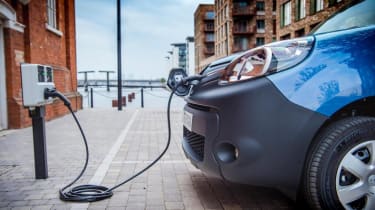Everything you need to know about the plug-in van grant, including what it is, which vehicles are eligible for it and how to apply
New ultra-low and zero emission vans purchased in the UK are eligible for the plug-in van grant – a Government subsidy that reduces the price of these commercial vehicles. The idea is to encourage businesses that can make the switch to electric vans to do so.
This policy is a key part of the country’s goal for every van on British roads to be electric by 2050, in turn enabling the target of net zero carbon by 2050 for the country as a whole.
Here’s everything you need to know about the plug-in van grant…
What is the UK plug-in car grant?
Which vans are eligible for the grant?
Contrary to what the name suggests, the plug-in van grant doesn’t apply to all vans with a plug. In order to qualify for the subsidy, a van must be capable of covering at least 60 miles in zero emission mode and must emit less than 50g/km of CO2 according to manufacturer-stated figures based on the official tests.
Technically, a plug-in hybrid van meeting these criteria would be eligible for the grant, but as no such vehicle is currently available on the market, the grant is effectively limited to fully electric vans.
How much is the plug-in van grant?
The value of the plug-in van grant varies according to the size of the van it’s being applied to. Eligible vans with a gross vehicle weight (GVW) of less than 2.5 tonnes can receive as much as 35 per cent of the purchase price, up to a maximum sum of £3,000.
Buyers of eligible vans with GVWs of between 2.5 and 3.5 tonnes can still only receive up to 35 per cent of the vehicle’s purchase price, but the cap is set higher at £6,000. Eligible vans with GVWs of 3.5 tonnes or more are catered for by a grant for small trucks – this is worth up to 20 per cent of the vehicle’s value, with a cap of £16,000.
Small vans eligible for the plug-in van grant
The Government’s list of electric vans weighing less than 2.5 tonnes that are eligible for the plug-in van grant (as of March 2021) is as follows:
- Maxus eDeliver 3 (short wheel base variants)
- Nissan e-NV200
- Renault Kangoo ZE
- Renault Zoe Van
Buyers can claim a grant worth 35 per cent of the purchase price of these vans, up to a maximum sum of £3,000.
Large vans eligible for the plug-in van grant
The Government’s list of electric vans with gross vehicle weights between 2.5 and 3.5 tonnes that are eligible for the plug-in van grant (as of March 2021) is as follows:
- BD Auto eTraffic
- BD Auto eDucato (3.5 tonnes)
- Citroen e-Dispatch
- LEVC VN5
- MAN eTGE
- Maxus eDeliver 3
- Maxus eDeliver 9
- Mercedes-Benz eVito
- Mercedes eSprinter
- Peugeot e-Expert
- Renault Master ZE
- Renault Trucks Master ZE
- Vauxhall Vivaro-e
- Volkswagen ABT e-Transporter
- LDV EV80
Buyers can claim a grant worth 35 per cent of the purchase price of these vans, up to a maximum sum of £6,000.
How do I apply for the grant?
The good news is that buyers don’t have to make any applications in order to benefit from the plug-in van grant. If you purchase an eligible van from a dealer, the appropriate discount will be automatically applied.
This sum is deducted from the van’s list price – it’s worth noting that any optional equipment selected by the customer is not included in the calculated list price and therefore does not affect the discount you receive.
Could your company manage with an electric van? Have you got one already? Tell us about it in the comments…
Source: Read Full Article



 What is the UK plug-in car grant?
What is the UK plug-in car grant?